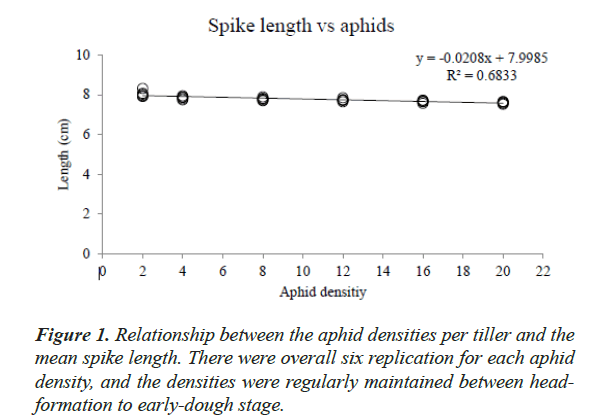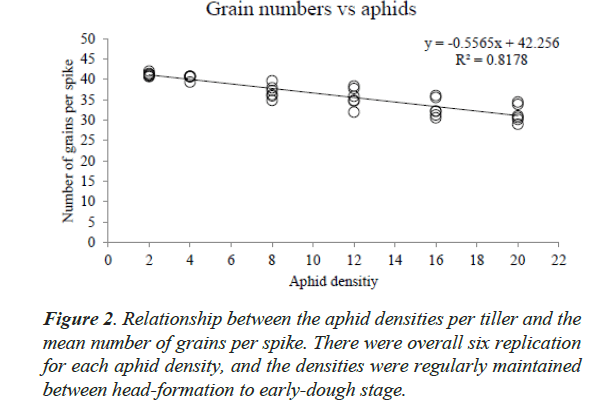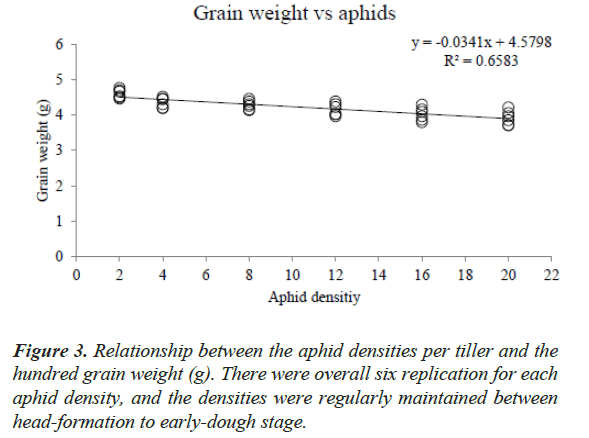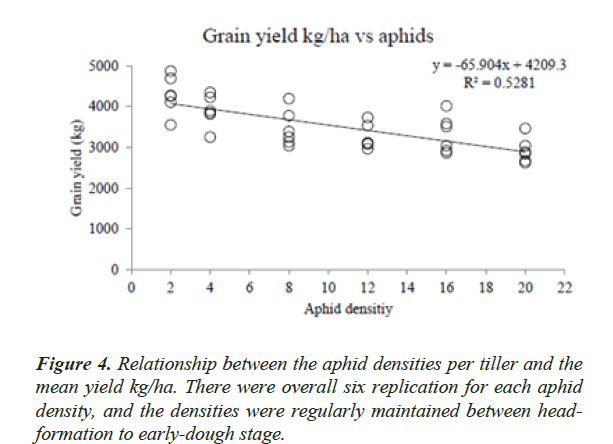Research Article - Journal of Agricultural Science and Botany (2019) Volume 3, Issue 2
Effect of aphid species infestation on wheat crop, Triticum aestivum L. and its yield.
1Department of Entomology, Faculty of Agricultural Sciences and Technology, Bahauddin Zakariya University, Multan, Pakistan
2Department of Entomology, University of Agriculture, Faisalabad, Pakistan
- *Corresponding Author:
- Syed Wafa Abbas
Department of Entomology
University of Agriculture, Faisalabad, Pakistan
E-mail:wafabukhari786@gmail.com
Accepted Date: July 05, 2019
Citation: Abbas SW, Niaz U. Effect of aphid species infestation on wheat crop, Triticum aestivum L. and its yield. J Agric Sci Bot 2019;3(1):17-20.
Abstract
Among cereal crops, wheat (Triticum aestivum L.) is an important staple food for human. Rhopalosiphum maidis, Rhopalosiphum padi, Schizaphis graminum and Sitobian avenae are the major aphid species of wheat in Pakistan, which cause huge yield losses in wheat crop. The study was conducted to check the effect of aphid density on wheat crop and its yield. Our observation was made from heading to early-dough stage. Mean spike length, number of grains per spike, 100 grains weight and yield kg/ha was significantly affected by the population density of an aphids. Aphid density was low correlated with mean spike length but it was significantly correlated with number of grains per spike, 100 grains weight and yield kg per hectare.
Keywords
Wheat crop, Triticum aestivum, Aphid species, Infestation level, Yield losses
Introduction
Wheat (Triticum aestivum L.) is an important and healthy cereal diet which is consumed as a staple food in many parts all over the world. About 20% of the world food calories and 40% of the food demand is fulfilled by the wheat [1]. Wheat has been cultivated on 8.7 million hectares with production of 24.2 million tons in Pakistan. It shares 10.1% to the value added in agriculture & 2.2% GDP share [2]. Gluten is a protein that is present in the wheat makes it unique [3].
Among the different insect pests, 29 species of the aphid are infested the wheat crop [4]. Aphid is the key sucking pest of wheat and other crops. It is the regular pest of wheat in Pakistan [5]. Rhopalosiphum maidis, Rhopalosiphum padi, Schizaphis graminum and Sitobia avenae are the major aphid species of wheat in Pakistan. Schizaphis graminum was the main pest among them [6] and Shizaphis graminum is major specie in Pakistan [7].
Aphid responds differently to different genotype of plant species while reducing the yield losses [8]. Aphid cause both direct and indirect damage by sucking the cell sap of phloem containing nitrogen contents while [9] the direct effect of aphid is promoted by directly sucking the cell sap and indirect effect is produced by secreting the honeydew that reduces the process of photosynthesis [10]. Aphid also transmits the viruses in plant (vector) Rhopalosiphum padi transmits the Barley Yellow Dwarf Virus (BYDV) by direct feeding of the host [11]. Rhopalosiphum padi can reduce the yield up to 600 kg/hectares in wheat [12]. Temperature fluctuation, aphidicide use, weeds interruption, plant density and time of sowing of wheat are the factors that influence the high population of aphid. Growing early maturing variety of wheat reduce aphid attack [13]. The time of sowing of wheat before 25th November gave high yield and low aphid population [14]. Aphid population is high in Feb-March due to the favourable host available in the wheat field [15]. Economic thresholds levels for aphid in wheat is justified, if 50 or more aphids are present in the seedling stage of the wheat. Moreover, 100 or more aphids are present during the 3-6 inches of plant height and 300 or more aphids when the plant reaches 6-10 inches in height and the visible damage of aphids is on the top terminal portion of leaves.
The main objective of our study is used to check the infestation level of aphid’s species on wheat crop and also their effects on yield.
Materials and Methods
The experiment was conducted at the Bahauddin Zakariya University, Multan, Pakistan on 16th March, 2018. The sowing time of wheat crop was 26th November, 2017 and harvesting time was 15th April, 2018. The crop was sown by broadcasting method in the field. The variety that was used in the wheat field was Faislabad-2008. The recommended dose of NPK fertilizers in the form of urea (128 kg/ha), DAP (114 kg/ha) and sulphate of potash (62 kg/ha) was applied. The infestation level of the aphids per tiller was maintained on the daily basis. The number of aphid population per tiller was maintained by the camel hair brush (between headings to early dough stage of wheat crop stage between Mid-march to end-March). The numbers of aphid was maintained at 2, 4, 8, 12, 16, and 20 aphids per tiller and were tagged. The experiment was laid out in a randomized complete block design with six treatments including control and six replications for each treatment. Treatment plots were randomly selected according to the given area in the field. Each plot size was kept as 1 m2. The 10 tillers were selected in 1 m2 plot and tagged. When the crop was matured, then wheat was harvested manually using sickle, and the produce from each treatment was tagged with the respective information and transferred to laboratory. Spike length of tillers was measured using measuring tape. Number of grains per wheat spike was calculated. Grains were manually threshed from spike and hundred grain were weight from each treatment, and the total grain weight obtained from a treatment/1 m2 was used for estimation of yield kg/ha.
The relation between aphid densities and wheat yield related parameters such as length of spike, number of grains per spike, weight of hundred grains and the final yield was assessed using Pearson correlations. Effect of aphid densities on length of spike, number of grains per spike, weight of hundred grains and the final yield were assessed using Analysis of Variance. All analysis was performed in SPSS version 21. Graphs were prepared in excel (version 2010).
Results
Comparison of different yield related parameters which were maintained by the different aphid densities at different wheat stages is shown in Table 1. Mean spike length was statistically greater (F5, 25=19.3, p<0.001) when densities were 2 per tiller than 4, 8, 12, 16 and 20 per tiller. Number of grains/spike was statistically greater (F5, 25= 91.64, p<0.001) in plots where the aphid population was 2 and 4 per tiller than in 8 and 12 16 and 20 per tiller. In case of grain weight 4,8,16 and 20 aphids per tiller showed statistically similar result, and the yield was comparatively less than plots where aphids were maintained as 2 per tiller (F5, 25=75.43, p<0.001). In case of yield kg/ha 2 and 4 (F5, 25=38.59, p<0.001) aphids per tiller were better able to yield than plots maintained with 8, 12 and 16, 20 aphids per tiller.
Table 1. Comparison of growth and yield-related parameters (mean±SE) of wheat plots which were maintained with different aphid densities from head formation stage to early-dough stage.
| Densities | Spike length (cm) | Grains per spike | Grain weight (g) | Yield kg/ha |
|---|---|---|---|---|
| 2 aphids/tiller | 8.04 ± 0.06 a | 41.24 ± 0.20 a | 4.60 ± 0.05 a | 4295 ± 189.72 a |
| 4 aphids/tiller | 7.85 ± 0.02 b | 40.53 ± 0.22 a | 4.35 ± 0.05 b | 3900 ± 156.70 b |
| 8 aphids/tiller | 7.78 ± 0.02 bc | 37.03 ± 0.68 b | 4.28 ± 0.05 b | 3467.5 ± 180.22 c |
| 12 aphids/tiller | 7.74 ± 0.02 bcd | 35.61 ± 0.94 b | 4.16 ± 0.07 c | 3257.5 ± 124.56 cd |
| 16 aphids/ tiller | 7.66 ± 0.02 cd | 33.01 ± 0.93 c | 4.03 ± 0.07 d | 3325 ± 185.72 c |
| 20 aphids/tiller | 7.60 ± 0.02 d | 31.56 ± 0.88 c | 3.92 ± 0.08 d | 2925 ± 124.84 d |
Mean values, within columns, sharing common alphabets are not significant (p>0.05; Tukey’s hsd test).
Effect of aphid density on spike length
Figure 1 shows that there was high correlation (RX=0.6833; Table 2) between spike length and aphid density that explained low extent of variation in spike length.
Effect of aphid density on number of grains/spike
Figure 2 shows that there was a significant correlation (R2=0.8178; Table 2) between the number of grains per spike and aphid density. When the aphid density was increased, the number of grains was reduced. The maximum number of grains was reduced on 20 aphids/tiller.
Table 2. Correlation between mean aphid densities per tiller and various growth and yield related parameters of wheat.
| Spike length (cm) | Grains/Spike | Grain weight (g) | Yield kg/ha |
|---|---|---|---|
| -0.827** | -0.904** | -0.811** | -0.727** |
| Correlation is significant at 0.01 level (N=36). | |||
Effect of aphid density on 100 grains weight
Figure 3 shows the negatively correlation (R2=0.6583; Table 2) between the aphid density and 100 grains weight. The 100 grains weight was affected by increasing the aphid density. In this case, the aphid density increased would reduce the weight of 100 grains.
Effect of aphid density on yield kg/ha
Figure 4 shows that the aphid density was significantly affected (R2=0.52; Table 2) on the yield kg/ha of the wheat. The low aphid density caused less reduction in yield. The higher number of aphid population resulted in greater reduction of yield kg/ha.
Discussion
It is studied that population density of aphids gradually increases when the crop reaches to the vegetative growth stage. The aphid infestation started in mid-January till the 15th of the March. Similar results were shown by Ahmad et al. [16] that was observed the aphids infestation started in first week of the February till increases up to mid of the March. While the aphid population was at peak between the heading-early dough stage on 1st April-3rd April and become reduced up to mid of the April. Our results are correlated with Chaojun and Nawaz who observed that aphids population became peak at heading stage [17,18].
In present study aphid’s population was low when the crop reaches to maturity stage. It is estimated by Riedell, [19] that infestation of aphids is greater between heading and flowering stage. In case of ripening the wheat, the aphid density gradually decreases.
Our findings showed that the mean spike length of wheat was not only the factor which effect on the yield of the crop. But number of grains per spike and the grain weight were the two important factors that cause reduction in yield. Mean spike length was literally effected the yield kg/ha. While the aphid’s population (16-20 aphids/tiller) showed the greater variation in the curve and affects the yield of the wheat crop and also reduces the grain weight and number of grains per spike respectively.
It is also studied that there was the high population density 20 Aphids/tiller during the grains development and the initiation of ripening stage. Similarly, it is correlated with the Kostyukovskiĭ and Kushnerik, 1990 [20].
Conclusion
The fundamental goal of our investigation is utilized to check the invasion level of aphid's species on wheat crop and furthermore their impacts on yield. Our observation was made from heading to early-dough stage. All the findings in the above study demonstrated that the mean spike length of wheat was not just the factor which impact on the yield of the harvest crop but number of grains per spike and the grain weight were the two important factors that cause reduction in yield.
References
- Wiese MV. Compendium of wheat diseases. American Phytopathological Society. 1987.
- Ahmed T, Aslam M, Hassan MW, et al. Aphids (Schizaphis graminum R.) population density on different wheat varieties (Triticum aestivum L.) and their comparative yields. J Agric Res. 2015;53(2):209-16.
- Kausar F, Shahbaz M. Interactive effect of foliar application of nitric oxide (NO) and salinity on wheat (Triticum aestivum L.). Pak J Bot. 2013;45(SI): 67-73.
- Géza K. Aphid flight and change in abundance of winter wheat pests. Arch Phytopathology Plant Protect. 2000;33(4):361-73.
- Aheer G, Ali A, Ahmad M. Abiotic factors effect on population fluctuation of alate aphids in wheat. J Agric Res. 2008.
- Haider SS, Hassan MW, Jamil M. Comparison of wheat varieties (Triticum aestivum L.) for aphid (Homoptera: Aphididae) infestation in relation to physico-morphic traits sown under semi arid climatic conditions. MAYFEB J Agric Sci. 2017;3:42-51.
- Rustamani M, Sheikh S, Memon N, et al. Impact of wheat plant phenology on the development of greenbug, Schizaphis graminum (Rodani). Pak J Zool. 1999;31:245-8.
- Rabbinge R, Sinke C, Mantel W. Yield loss due to cereal aphids and powdery mildew in winter wheat. Mededelingen-Universiteit Gent, Faculteit Landbouwkundige en Toegepaste Biologische Wetenschappen. 1984;48:1159-68.
- Vereijken PH. Feeding and multiplication of three cereal aphid species and their effect on yield of winter wheat. Wageningen: Pudoc. 1979.
- Bardner R, Fletcher KE. Insect infestations and their effects on the growth and yield of field crops: a review. Bulletin of Entomological Research. 1974;64(1):141-60.
- Stern VM. Control of aphids attacking barley and analysis of yield increases in the Imperial Valley, California. J Econ Entomol. 1967;60:485-90.
- Hallqvist H. Bekampningstrosklar för havrebladlus (Rhopalosiphum padi) i varsadresultat fran Mellansverige. 32nd Swedish Crop Protection Conference. 199;197-205.
- Acreman TM, Dixon AFG. Developmental patterns in wheat and resistance to cereal aphids. Crop Prot. 1985;4(3):322-8.
- Aheer G, ul Haq I, Ahmad K, et al. Varietal resistance and sowing date effect on aphid density and wheat yield. J Agric Res. 1993.
- Aheer G, Ahmad K, Ali A. Role of weather in fluctuating aphid density in wheat crop. J Agric Res (Pakistan). 1994.
- Ahmad KF. Incidence of the cereal aphid, Sitobion avenae (F.) on different cultivars of wheat. Sarhad J Agric. 1989;5:59-61.
- Chaojun X. Study on the relationship between occurrence of Rhopalosiphum padi (L.) and the growing period of wheat. Insects Knowledge (China). 1990.
- Nawaz H. Insect pest of wheat and effect of fertilizer (NPK) on aphid’s population. M. Sc (Hons) thesis Department of Entomology Agricultural University Peshawar. 2000.
- Riedell WE. Tolerance of wheat to Russian wheat aphids: nitrogen fertilization reduces yield loss. J Plant Nutr. 1990;13(5):579-84.
- Kostyukovskiĭ MG, Kushnerik VM. Population dynamics of cereal leaf aphids on winter wheat. Zashchita Rasteniĭ (Kiev). 1990;37:10-3.



